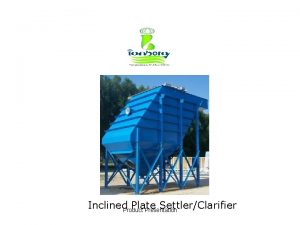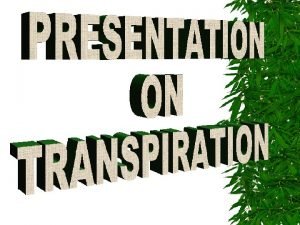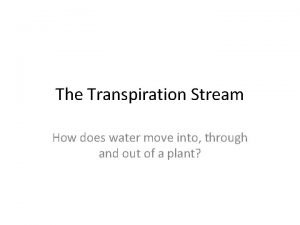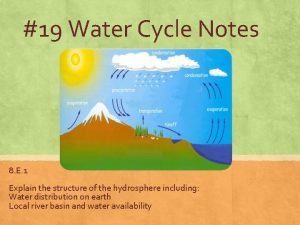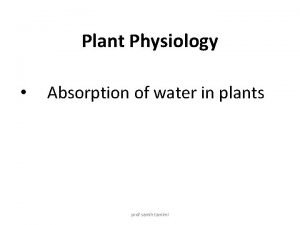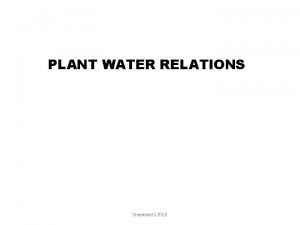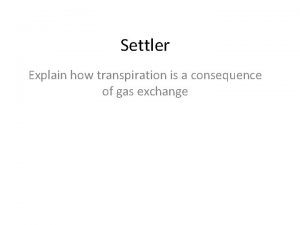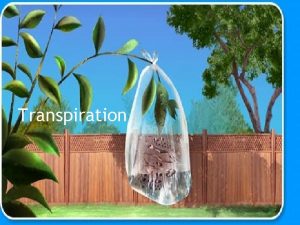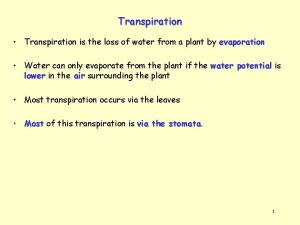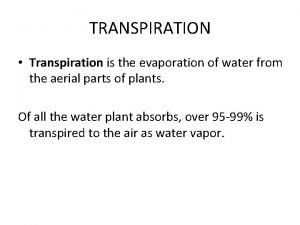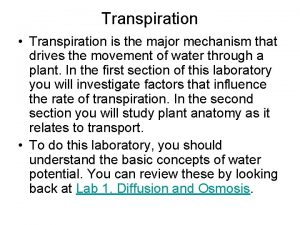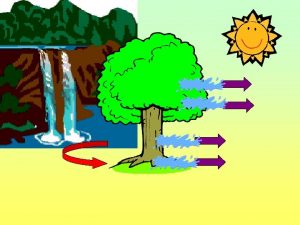Settler Explain how transpiration is a consequence of
















- Slides: 16

Settler Explain how transpiration is a consequence of gas exchange

Module 3 Exchange and transport 9. 3 Transpiration (2 lessons)

Starter • A 3 memory game of a labelled potometer

Learning Objectives • Define the term transpiration Success Criteria • Define the term transpiration (Grade D – C) • Describe the factors that affect transpiration rates and how a potometer is used to measure these (Grade C –B) • Describe how a potometer, with the aid of diagrams, is • Explain how practical investigations are used to estimate transpiration rates (Grade B – A) • Describe the factors that effect transpiration rate

Transpiration • Transpiration is the loss of water vapour from the upper parts of the plant by evaporation. Transpiration involves 3 processes 1) Osmosis from the xylem to mesophyll cells 2) Evaporation from the surface of the mesophyll cells to the intercellular spaces 3) Diffusion of water vapour from the intercellular spaces out through the stomata • Define the term transpiration (Grade D – C)

Why do plants need transpiration? A transpiration pull effect is needed to transport large volumes of water up the stems of large plants/trees to the leaves. As well as providing water for photosynthesis, dissolved ions, sugars and hormones are also moved about in the transpiration stream. Transpiration is a bit like a straw, pulling water up the plant. Sometimes the pulling force will be stronger and the plant will lose more water. Giant Redwood trees can lose 700 litres of water per day

Rate of transpiration This is the amount of water vapour that a plant loses from it’s leaves and stems per unit time. It depends on several variables: • Size of the plant • Thickness of the waxy cuticle • How widely space the stomata are • Whether the stomata are open or closed. These are all biotic factors

Rate of transpiration The rate of transpiration also varies depending on the plant’s environment. These are abiotic factors l humidity (amount of moisture in the air) l light intensity l temperature l air movement (wind).

Why does transpiration vary?

Factors affecting transpiration Factor How factor affects transpiration: Increase in transpiration caused by: Decrease in transpiration caused by: Light Stomata open in light and close in dark Higher light intensity Lower light intensity Temperature Alters the kinetic energy of the water molecules and the relative humidity of the air Higher temperature Lower temperature Humidity Affects the water potential gradient between the air spaces in the leaf and the atmosphere Higher humidity Lower humidity Air movement Changes the water potential gradient by altering the rate at which moist air is removed from around the leaf More air movement Less air movement

Measuring water loss • Enclose the pot of a potted plant in a plastic bag and put the plant on a top-pan balance. The mass gradually falls as water evaporates off the surface s of the plant.

Measuring uptake of water Transpiration can be measured using a potometer. A cut plant stem is sealed into the potometer using a rubber bung. An air bubble is introduced to the capillary tube. The distance the bubble travels shows how much water the stem has taken up. This gives an indirect measurement of the rate of transpiration (i. e. it measure water uptake).

Potometer experiment Problem is that potometer is only an estimate • Measures water uptake ; • Not all water (taken up) is lost. 99% water taken up is lost • Some water used is used in photosynthesis / making cells turgid

Potometer What is a potometer? • A piece of apparatus used to measure the rate of transpiration (water loss from a plant). Why are the effects of photosynthesis and respiration usually ignored when taking potometer readings? • Because the volume of water involved in metabolic processes is insignificant compared to the large volume constantly flowing through the plant in the transpiration stream. If you were comparing transpiration rates of several leaves, what leaf feature should be measured to obtain a fair comparison? • Surface area of the leaves.

Potometer What precautions must be followed when setting up a potometer? • Caution should be taken when preparing holes in rubber bungs, pushing the glass tube, the cutting and the syringe into the bung. • It is crucial to avoid air bubbles in the assembled potometer. • The plant stem must be cut under water to prevent airlocks forming in the xylem. • All fittings must be tight so that the only way the apparatus can lose water is by the plant transpiring. • Try to avoid getting the leaves of the shoot wet when assembling the potometer in the sink, as this significantly slows down subsequent transpiration.

plenary • Jan 10 Question 4 - homework • Describe the factors that affect transpiration rates and how a potometer is used to measure these (Grade C –B)
 Settler unscramble
Settler unscramble Inclined plate settler
Inclined plate settler Pioneer migrator settler map example
Pioneer migrator settler map example Pioneer-migrator-settler map
Pioneer-migrator-settler map Settler colonies ap world history
Settler colonies ap world history Plate settler clarifier
Plate settler clarifier Pioneer migrator settler map example
Pioneer migrator settler map example Transpiration is the evaporation of water from
Transpiration is the evaporation of water from What is transpiration
What is transpiration Transpiration stream meaning
Transpiration stream meaning Kalviamuthu blogspot
Kalviamuthu blogspot Water cycle and transpiration
Water cycle and transpiration Stomatum
Stomatum Transpiration
Transpiration Role of water in plant growth
Role of water in plant growth Whats the definition of transpiration
Whats the definition of transpiration Adhesion cohesion
Adhesion cohesion





